The Kinetrol rotary vane design is based upon a single moving part which eliminates additional parts required to convert linear motion to rotary motion. This simple and innovative design provides a highly accurate and extremely reliable actuator for operating valves, drives and dampers, and is perfectly suited for the most demanding process control applications. For more information visit www.kinetrolusa.com or call 972-447-9443.
Showing posts with label valve. Show all posts
Showing posts with label valve. Show all posts
Trouble-free Pneumatic Valve and Damper Actuators
A rugged, corrosion-resistant pneumatic vane actuator with only a single moving part, the Kinetrol vane actuator is warranted to operate trouble-free for millions of cycles.
With millions of actuators performing reliably around the world, the Kinetrol vane actuator's outstanding cycle life, smooth and precise movement, and environmentally rugged design makes it the best choice for all of your automated valve requirements.
Kinetrol USA
https://kinetrolusa.com
972-447-9443
Kinetrol Actuator "Insures" Rapid Valve Closing to Protect Equipment, Infrastructure, and Personnel
 |
| 20" high performance butterfly valve with Kinetrol actuator |
Requirement:
It's necessary to prevent a $30M USD axial process air compressor from rapidly going into an overspeed condition that could harm equipment, infrastructure, and personnel.
Challenge:
 The biggest challenges: stroking the valve in under one second, but without slamming the butterfly disc into the stops which can damage the valve and nearby equipment.
The biggest challenges: stroking the valve in under one second, but without slamming the butterfly disc into the stops which can damage the valve and nearby equipment.
Solution:
Kinetrol's expertise in rapid cycling enabled us to size, select, and perform certified cycle time tests on the final assembly. This shut out any competition.
Assembly:
20" class 300 high performance butterfly valve, Kinetrol 207-120 with a 2" automatic L-Port, 3-way, compressed air supply ball valve with 097-F120, X-proof solenoid, and two exhaust silencers coupled to the size 20 supply port. Open / closed limit switch assembly. Robust SST mounting bracket and coupling. The closure time once actuator air is exhausted: 0.13 seconds.
Kinetrol Blueline Actuator for Use in Foodservice and Beverage Processing
Kinetrol's "Blueline" Series of pneumatic vane actuators for use in foodservice and beverage processing. The actuators are intended to be installed in areas where harsh chemical wash-down is required. These areas are very tough on most types of pneumatic actuators because the caustic or acidic chemicals used in cleaning adversely effect the actuator. Kinetrol's Blueline Series provides a very economical option these areas.
Cement Hopper Valve Actuator Requires Kinetrol's Accuracy, Dependability and Toughness
 |
| Location of the actuator and valve at bottom of hopper. |
No only did this approach require a human operator (with associated costs and safety precautions) to be present, the manual system didn't provide the degree of control the company needed. Careful control of the cement into the truck is important because uncontrolled flow, or too rapid a flow, will overwhelm the dust collection system and allow fugitive emissions (dust) to escape to the atmosphere. A serious regulatory and safety issue.
 |
| Kinetrol actuators and positioners perform in dirt and dust. |
For more information, contact Kinetrol USA by visiting https://kinetrolusa.com or by calling 972-447-9443.
Pneumatic Valve and Damper Actuators Designed to Stand Up to the Cement Industry
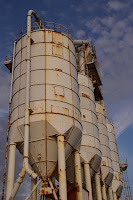 |
| Cement silos. |
Because of their reliability and ruggedness, Kinetrol rotary vane actuators are used in many processes across a cement plant. These applications include vehicle unloading, silo discharge, air cooling dampers, distribution, bagging and emissions control.
You can download a PDF that outlines where vane actuators are used in all areas of cement production here, or you can read the embedded document below.
Industrial Valve Actuator Types
 |
| Lever actuator (with failsafe spring return) |
Manual
Manual actuators are capable of placing the valve in any position but do not permit automatic operation. The most common type mechanical actuator is the handwheel. This type includes handwheels fixed to the stem and handwheels connected to the stem through gears.
Electric Motor Actuators
 |
| Gear operator (attached to pneumatic actuator) |
Electric motors permit manual, semi-automatic, and automatic operation of the valve. Motors are used mostly for open-close functions, although they are adaptable to positioning the valve to any point opening. The motor is usually a, reversible, high speed type connected through a gear train to reduce the motor speed and thereby increase the torque at the stem. Direction of motor rotation determines direction of disk motion. The electrical actuation can be semi-automatic, as when the motor is started by a control system. A handwheel, which can be engaged to the gear train, provides for manual operating of the valve. Limit switches are normally provided to stop the motor automatically at full open and full closed valve positions. Limit switches are operated either physically by position of the valve or torsionally by torque of the motor.
Pneumatic Actuators
 |
| Pneumatic actuator |
Hydraulic Actuators
Hydraulic actuators provide for semi-automatic or automatic positioning of the valve, similar to the pneumatic actuators. These actuators use a piston to convert a signal pressure into valve stem motion. Hydraulic fluid is fed to either side of the piston while the other side is drained or bled. Water or oil is used as the hydraulic fluid. Solenoid valves are typically used for automatic control of the hydraulic fluid to direct either opening or closing of the valve. Manual valves can also be used for controlling the hydraulic fluid; thus providing semi-automatic operation.
Solenoid Actuated Valves
 |
| Solenoid valve (attached to pneumatic actuator) |
Single solenoid valves are termed fail open or fail closed depending on the position of the valve with the solenoid de-energized. Fail open solenoid valves are opened by spring pressure and closed by energizing the solenoid. Fail closed solenoid valves are closed by spring pressure and opened by energizing the solenoid. Double solenoid valves typically fail "as is." That is, the valve position does not change when both solenoids are de-energized.
One application of solenoid valves is in air systems such as those used to supply air to pneumatic valve actuators. The solenoid valves are used to control the air supply to the pneumatic actuator and thus the position of the pneumatic actuated valve.
Contact Kinetrol USA for any valve actuation challenge. They can be reached at https://kinetrolusa.com or by calling 972-447-9443.
Corrosive Flow Control Requirement? Use Thermoplastic Valves and Corrosion Resistant Rotary Actuators
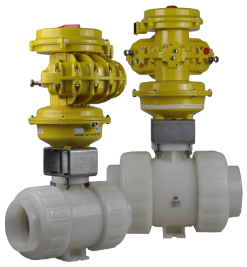 |
| Thermoplastic valves with corrosion resistant actuators, springs and positioners. (Kinetrol) |
Thoughtful actuator selection is required when plastic valves are specified. While the mechanics in applying pneumatic actuators to plastic quarter-turn valves is no different than metallic valves, the characteristics of the process and application can have significant impact on the performance the automated valve.
The assumption is that, if a thermoplastic valve is required, there is an higher probability the of exposure to corrosive media, or the automated valve assembly is located in a corrosive atmosphere, and therefore a corrosion resistant pneumatic actuator is preferred. Considering this, an actuator with internal and external parts protected by epoxy resins or special paints should be applied. Additionally, actuator spring systems should be designed in way to prevent exposure to corrosive media.
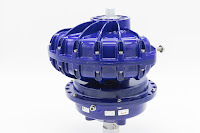 |
| Corrosion resistant rotary vane actuator with special external coating. (Kinetrol Blueline). |
The rotary vane actuators manufactured by Kinetrol standardly meet theses requirements. Engineered specifically for high-cycle, dirty, and corrosive applications, these very hardy, compact actuators come standardly with an epoxy stove enamel finish, stainless steel internal and external hardware, with spring units that are totally sealed from the atmospheric contaminants. For applications requiring greater corrosion resistance, such as caustic wash-down or salt-laden environments, an optional "Blueline" coating can be applied,
Kinetrol Product Catalog October 2017
Most recent version of Kinetrol catalog including Blueline coating for foodservice applications. Kinetrol rotary vane actuators are used to operate or position ball, butterfly and plug valves, ventilation dampers and automatic doors. Uses also include movement and positioning of components during manufacture - in fact anything that needs to be turned through 90° or less, automatically or by remote control.
You can download the Kinetrol Product Catalog from the Kinetrol USA site here.
You can download the Kinetrol Product Catalog from the Kinetrol USA site here.
Labels:
actuation,
actuator,
automation,
food and beverage,
industrial,
valve
The Role of Industrial Valve Actuators
Thanks to actuators, multiple valves can be controlled in a process system in a coordinated fashion; imagine if, in a large industrial environment, engineers had to physically adjust every valve via a hand wheel or lever! While that manual arrangement may create jobs, it is, unfortunately, completely impractical from a logistical and economic perspective. Actuators enable automation to be applied to valve operation.
 |
| Pneumatic vane actuator with spring return and positioner on plastic body valve. |
Pressurized-liquid reliant devices are known as hydraulic actuators. Electric actuators, either motor driven or solenoid operated, rely on electric power to drive the valve trim into position. With controllers constantly monitoring a process, evaluating inputs, changes in valve position can be remotely controlled to provide the needed response to maintain the desired process condition.
Manual operation and regulation of valves is becoming less prevalent as automation continues to gain traction throughout every industry. Valve actuators serve as the interface between the control intelligence and the physical movement of the valve. The timeliness and automation advantages of the valve actuators also serve as an immense help in risk mitigation, where, as long as the system is functioning correctly, critical calamities in either environmental conditions or to a facility can be pre-empted and quickly prevented. Generally speaking, manual actuators rely on hand operation of levers, gears, or wheels, but valves which are frequently changed (or which exist in remote areas) benefit from an automatic actuator with an external power source for a myriad of practical reasons, most pressingly being located in an area mostly impractical for manual operation or complicated by hazardous conditions.
Thanks to their versatility and stratified uses, actuators serve as industrial keystones to, arguably, one of the most important control elements of industries around the world. Just as industries are the backbones of societies, valves are key building blocks to industrial processes, with actuators as an invaluable device ensuring both safe and precise operation.
Actuator Sensor Interface for Kinetrol Vane Actuators
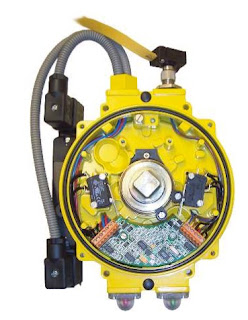 |
| Kinetrol AS Interface |
The slave devices will always function in response to commands sent by the master device, either to actuate, or to return a message reporting the value of a sensed variable, or both. The AS interface 2.1 specification allows 31 slave devices to be powered by a DC voltage fed into the same two-cable wire used as the communication bus, with allowed power consumption adequate to drive the slave plus a standard pneumatic solenoid valve. Under extended addressing, a maximum of 62 slave devices can be connected via one bus, but specified limits on device capacitance make this applicable only to systems with limited numbers of solenoid valves, or with a special scheme to get round the limit (see overleaf).
An AS interface bus can be used as the final field link in a more complex hierarchy of devices making up a large plant-wide control system. Actuators and sensors must often be installed in unprotected environments where conditions can be demanding; the AS interface bus is ideal for using as the link between these field devices and the “indoor” equipment making up the upper part of the control system.
AS interface is well suited to on/off control and monitoring, and is a good choice when a simple economical, reliable and robust solution is required to control and monitor a series of actuators and sensors in a process control or machine application. Kinetrol’s AS interface Universal Limit Switch Box is designed to meet all of these requirements.
The Kinetrol AS interface circuit board is fitted inside a standard actuator-mounted Kinetrol Universal Limit Switch Box (2 or 4 entry), so that the actuator (and up to 30 others like it) can be controlled, monitored and powered directly via a single two-conductor digital communication cable (or bus), using the open AS interface 2.1 standard. All the advantages of the limit switch box (all-metal construction, corrosion resistant, up to IP67 sealing, easy connection, easy setting of limit switch strikers etc - see KF487 literature) combined with the highly specified AS interface circuit to give unique levels of practicality, genuine industrial quality, and use-anywhere adaptability.
See thr full feature set and documentation below.
Need a Fail-Safe Valve Operator? Use This One.
 |
| Kinetrol manual fail-safe spring unit. |
These spring return units are designed to be put on valves to prevent, or limit, the impact of potentially hazardous accidents resulting from uncontrolled flowing fluid and gasses or spillage.
The Kinetrol manual fail-safe spring unit has a ISO/DIN female drive for direct mounting and ATEX category 2 options for use in hazardous areas. Kinetrol also offers a range of fire fail-safe spring assemblies that can be set to operate valves at pre-configured temperatures.
Because they cannot be left in the wrong position, they are commonly referred to as "deadman handles". Theses devices provide reliable torque delivery for valve reseating and come with completely sealed spring housings that meet IP65 levels, totally protecting the internal spring from the environment, making them ideal for outdoor applications.
Kinetrol P3 On/Off Positioner
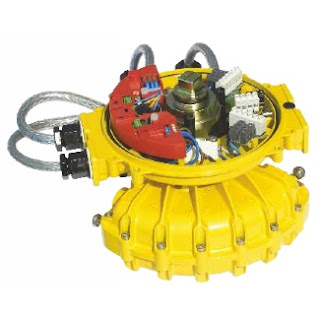 |
| Kinetrol P3 On/Off Positioner |
The Kinetrol P3 On/Off positioner consists of an electronic positioning circuit mounted in a robust all-metal enclosure, which controls a 1⁄4-turn rotary pneumatic actuator via standard on-off solenoid valves direct-mounted on the actuator’s own interface.
The P3 circuit is designed so that its assembly can be mounted inside a standard Kinetrol limit switch box (either ULS-type, or explosion proof XLS-type), using only two screws. The P3 assembly is complete with feedback potentiometer and anti-backlash gear drive, which engages with gear teeth on the limit switch coupling to read the actuator’s position. The limit switch coupling complete with gear teeth needs to replace the standard coupling if a standard box is being retrofitted with a P3.
The positioner circuit is powered by the mid-point input voltage. It functions by comparing the actual mid-point position (read by the feedback potentiometer) with the set position (set via an on-board preset, or a remote preset, or a remote 4-20mA signal). The positioner circuit uses its solid-state switched outputs to power solenoid valves which drive the actuator towards the position where the set position corresponds with the actual position. When it gets there, the solenoids are switched to hold that position.
The positioner circuit incorporates a unique power supply allowing it to be powered by any of 24vDC, 48vDC, 115vAC or 230vAC, 50/60 Hz, without the need for any change. The supply maintains full isolation of the low voltage control circuit from the power input line (up to 5Kv). Switching of the solenoid valve outputs is achieved through opto-isolated solid state switches which operate at all the above voltages – only the solenoid coils themselves need to be adapted specifically to the supply voltage. The use of solid state switching avoids any limitations on relay contact life.
Double acting models are available as fail-free (standard), fail-down (moves clockwise on loss of electrical power if air supply is still present) and fail-hold (holds position on loss of electrical and / or air supply) variants. Spring return models move in the direction of the spring on loss of electrical failure, but hold position on loss of air. An external pressure switch (which cuts electrical power on loss of air pressure) should be fitted by the customer if spring function is required on loss of air and / or electrical power.
An optional angle retransmit (AR) circuit can be retrofitted by plugging it into the top of the positioner circuit and fixing with three screws. The AR circuit is a 2-wire loop-powered 4-20mA device, which reads the position of the positioner’s feedback pot. It is fully functional whether or not the positioner circuit is powered, and the feedback signal is electronically isolated (ie. floating) relative to the low voltage positioner circuit (which in turn is electrically isolated from the power supply and solenoid connections).
Extra solid-state switches have been incorporated on the positioner board to allow supply to both solenoid valves via a single cable for movement to the upscale position when the positioner is in spring-return or fail-down mode, while still allowing the positioner to control the two valves independently for the mid position. If the mid-position input is energised, then these extra switches isolate the solenoids from the upscale/downscale inputs.
The three power input lines (for up, mid, down positions) are independently fused using plug-in miniature fuses on the positioner circuit board.
External connections are made via a multi-option connector board, which allows simultaneous connection of up to four changeover limit switches, three control supply inputs plus neutral/negative, and a single low-voltage signal. This connector board, like the positioner circuit assembly, mounts in either the standard ULS or XLS box using two screws.
If an angle retransmit circuit is fitted using the low voltage signal terminal, optional 4-20mA inputs or external setpoint pot wires can be connected either directly to the terminal block on the positioner circuit or, if only three or less limit switches are in use, relayed through an unused limit switch terminal on the connector board.
The limit switch box is fitted with a ground terminal which must be connected to a suitable external ground.
Industrial solenoid valves which permit the use of standard quality air supplies (instrument quality air is not required) are direct-mounted on adaptor blocks on the side of the actuator, and electrically connected via steel-armoured flying leads with DIN sockets on the solenoid end. At the positioner end, they connect to two 2-way terminal blocks on the circuit board. A range of solenoid valve options are available, determined by the function required, the supply voltage, and whether or not the unit requires hazardous area certification.
The positioner circuit is powered by the mid-point input voltage. It functions by comparing the actual mid-point position (read by the feedback potentiometer) with the set position (set via an on-board preset, or a remote preset, or a remote 4-20mA signal). The positioner circuit uses its solid-state switched outputs to power solenoid valves which drive the actuator towards the position where the set position corresponds with the actual position. When it gets there, the solenoids are switched to hold that position.
Need More Information?
Contact Kinetrol USA at
or call 972-447-9443.
The positioner circuit incorporates a unique power supply allowing it to be powered by any of 24vDC, 48vDC, 115vAC or 230vAC, 50/60 Hz, without the need for any change. The supply maintains full isolation of the low voltage control circuit from the power input line (up to 5Kv). Switching of the solenoid valve outputs is achieved through opto-isolated solid state switches which operate at all the above voltages – only the solenoid coils themselves need to be adapted specifically to the supply voltage. The use of solid state switching avoids any limitations on relay contact life.
Double acting models are available as fail-free (standard), fail-down (moves clockwise on loss of electrical power if air supply is still present) and fail-hold (holds position on loss of electrical and / or air supply) variants. Spring return models move in the direction of the spring on loss of electrical failure, but hold position on loss of air. An external pressure switch (which cuts electrical power on loss of air pressure) should be fitted by the customer if spring function is required on loss of air and / or electrical power.
An optional angle retransmit (AR) circuit can be retrofitted by plugging it into the top of the positioner circuit and fixing with three screws. The AR circuit is a 2-wire loop-powered 4-20mA device, which reads the position of the positioner’s feedback pot. It is fully functional whether or not the positioner circuit is powered, and the feedback signal is electronically isolated (ie. floating) relative to the low voltage positioner circuit (which in turn is electrically isolated from the power supply and solenoid connections).
Extra solid-state switches have been incorporated on the positioner board to allow supply to both solenoid valves via a single cable for movement to the upscale position when the positioner is in spring-return or fail-down mode, while still allowing the positioner to control the two valves independently for the mid position. If the mid-position input is energised, then these extra switches isolate the solenoids from the upscale/downscale inputs.
The three power input lines (for up, mid, down positions) are independently fused using plug-in miniature fuses on the positioner circuit board.
External connections are made via a multi-option connector board, which allows simultaneous connection of up to four changeover limit switches, three control supply inputs plus neutral/negative, and a single low-voltage signal. This connector board, like the positioner circuit assembly, mounts in either the standard ULS or XLS box using two screws.
If an angle retransmit circuit is fitted using the low voltage signal terminal, optional 4-20mA inputs or external setpoint pot wires can be connected either directly to the terminal block on the positioner circuit or, if only three or less limit switches are in use, relayed through an unused limit switch terminal on the connector board.
The limit switch box is fitted with a ground terminal which must be connected to a suitable external ground.
Industrial solenoid valves which permit the use of standard quality air supplies (instrument quality air is not required) are direct-mounted on adaptor blocks on the side of the actuator, and electrically connected via steel-armoured flying leads with DIN sockets on the solenoid end. At the positioner end, they connect to two 2-way terminal blocks on the circuit board. A range of solenoid valve options are available, determined by the function required, the supply voltage, and whether or not the unit requires hazardous area certification.
KEY FEATURES
- Robust modulating actuator, control tolerant of standard air quality (instrument air quality is not necessary).
- Three position rotary control using only three electrical inputs plus air supply.
- Two endstop positions + adjustable mid position anywhere in angular range of actuator (90 or 180°).
- Control circuit mounts inside standard all metal industrial quality Kinetrol ULS or XLS limit switch boxes without disturbing limit switches – available fully assembled, or (on non-explosion proof models only) for user retrofit to existing boxes.
- Direct mounting onto full range of Kinetrol 1⁄4 turn actuators. Namur mounting options available.
- Uses direct-mounting standard solenoid valves outside box to position actuator.
- Easy adjustment of mid position set point by switch–selectable choice of methods: on-board pot, remote pot or 4-20mA input signal.
- Explosion proof options available (approved to IECEX, ATEX; FM (for USA & Canada) standards pending) by use of XLS housing plus standard explosion proof solenoid valves.
- All new positioner circuit – runs on any of 24vDC, 48vDC, 115vAC or 230vAC power without any change required.
- Solid-state universal-voltage solenoid switching – no mechanical contacts.
- Three separate on-board mains fuses for three inputs.
- Switchable selection of mid-point setting method (on-board preset, remote preset, remote 4-20mA signal).
- Switchable selection of double acting or spring return operating mode.
- Power input isolated from signal inputs and outputs for all voltage options.
- Moulded reinforced plastic internal circuit cover for insulated safety.
- Positioner has user-adjustable zero, span, deadband and damping parameters via preset pots for easy optimization of positioning performance.
- Damping parameter gives velocity-proportional setpoint advance to allow better stabilization of fast-moving or high inertia loads while maintaining resolution and repeatability.
- Retrofittable isolated loop-powered 4-20mA angle-retransmit circuit available – just plugs in inside same enclosure – with its own user-adjustable zero and span presets.
Need More Information?
Contact Kinetrol USA at
www.kinetrolusa.com
or call 972-447-9443.
Cement Silos Need Valve Actuators with Power and Reliability
 |
| Kinetrol spring return actuator on cement silo valve. |
One particular cement processing plant needed a replacement for their main silo off loading valves. These valves fill cement trucks the company used to deliver their product.
The plant's existing valves were poorly applied for this use and were causing major headaches. The valves were designed with thin steel plate, large gaps between the valve body and disc, and rubber seals that wore away, leading to cement leaking through the valve. The leaking cement would spill onto a feed trough where it would cake and require manual cleaning - an expensive and time consuming operation. If the valve didn’t leak, this expense and time would be saved.
A custom valve manufacturer was called in to use their engineering and fabrication expertise to develop a custom valve that would last. The result was a new rotary valve that uses a much hardier wear plate, and the rotor and body are carefully machined with only a 2/100ths of an inch gap between them. Additionally, the design provides a mechanism to catch any cement should any ever make it through the gap.
The new, custom designed valve needed an actuator that would be equally reliable. The selection of Kinetrol vane actuator with a spring return was the most obvious because its power and its reliability. With only one moving part and no complex linkage to wear out, it was the best choice for long life. The combination of valve and actuator is expected to last many thousands of operations with no maintenance.
Procedure for Calculating Distance of Actuator from Hot Valve
The purpose of this post is to assist in determining the proper distance of a Kinetrol actuator from a hot valve.
In many situation, valves are put inline with a hot process media flowing through the piping system. In these situations, careful consideration must be taken to avoid over temperature exposure of the Kinetrol actuator via conductive or radiant heat.
The following formulae will assist in giving you data to calculate the safe distance between hot valve and actuator.
If you need assistance, or have any concerns about properly distancing the actuator from your process, it's always best to consult with the experts at Kinetrol USA. They're just a phone call away. For more information visit www.kinetrolusa.com or call 972-447-9443.
In many situation, valves are put inline with a hot process media flowing through the piping system. In these situations, careful consideration must be taken to avoid over temperature exposure of the Kinetrol actuator via conductive or radiant heat.
The following formulae will assist in giving you data to calculate the safe distance between hot valve and actuator.
For steel RHS mount kits, standard (80°C Max.) actuators
In ambient 50°C air.
Kinetrol + Plug Valve = Optimum Sludge Valve Performance
 |
| Water treatment plant |
Many valve manufacturers specify high-pressure/high-torque actuators to overcome the sludge. Many times they choose linear type valves and screw-type linear actuators because they provide the brute force needed to push through the sludge. An unwanted side-effect of using linear valves and actuators is that the same force used to push the disc through the sludge, also causes valve damage by pushing and grinding solids into the valve seats, disc and seals. Eventually, the valve becomes so damaged it no longer provides proper shut-off.
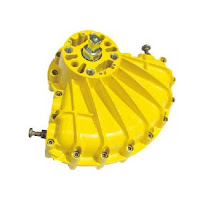 |
| Kinetrol actuator |
For sludge applications, Kinetrol rotary vane actuators mounted on quarter-turn plug valves are a great choice . The combination of the high cycle actuator design, with the design benefits of a plug valve, offer wastewater treatment operators a valve assembly that will provide years of trouble-free life.
Fit and Forget, Worry-free Pneumatic Valve Actuators
Here's a short, narrated introduction to the Kinetrol vane actuator and their use on industrial valves. Kinetrol's 60 years of applying "fit & forget, worry about something else" actuators has rightfully earned their reputation for being the most durable, long-lasting valve actuator on the market today - a statement backed by a 4 million cycle warranty and documented, real-world field installations where the actuator provided upwards of 30 million maintenance-free cycles.
For more information, visit http://www.kinetrolusa.com.
For more information, visit http://www.kinetrolusa.com.
What Is a Vane Actuator?
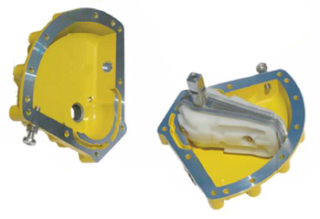 |
| Inside view of a vane actuator showing the clam-shell design, internal chamber layout, and double-sided vane. |
Linear motion gas/hydraulic cylinder or piston actuators use gears to convert linear to rotary motion. Vane actuators employ a rigid vane inside a sealed chamber that is connected directly to the drive shaft at one end with no gears. The result is much smoother rotary movement and greater cycle life.
Vane actuators operate by introducing a fluid or gas to either side of it's enclosure through inlet/outlet ports, creating the force required for movement. Advanced vane actuators utilize double sided vanes that allow for pressurization of both sides, allowing for bi-directional movement. The vane itself provides an arc movement in the far side (opposite the shaft) of the actuator, translating rotary movement back to its integrated shaft.
The vane actuator shaft is designed to connect directly to a device (valve, damper, ergo mechanism) for the transfer of movement. In advanced design vane actuators, the shaft is completely sealed from the pressurized side of the vane via “lip seals” which act to prevent the loss of air/gas/oil through shaft seals or bearings. With the help of spring steel supports, the lip seals are kept in constant contact with the inner surface of the chamber wall at all times during rotation. A side benefit of lip seals are the self-cleaning or sweeping action they provide to the inside chamber surfaces.
Since the double-sealed vane separates the vane actuator chamber in two sides, movement in either direction can be changed merely by creating a pressure differential on either side of the vane. Inlet/outlet ports allow for the pressurization and de-pressurization for either side. As gas or fluid is introduced to one side, the vane is forced away, toward the opposite side. By reversing the pressure and vent ports, and pressurizing the opposite chamber, the actuator moves in the opposite direction.
When vane actuators use only gas or fluid as their source for movement in both directions, they are referred to as “double acting”. When an optional spring is used to provide the power in one direction (open or close) they are referred to as “spring return”.
For more information on vane actuators, visit http://www.kinetrolusa.com
The ISO 5211 Valve Mounting Flange and Actuator Connection
 |
| Valve with ISO 5211 Flange |
A standard interface between actuator, valve, solenoids, and positioners provides many benefits. Actuated valve assemblies are installed in a very wide range of applications and operating conditions resulting in many custom designs. Understanding the connection between these components is critical for long life, safety, and performance.
A standard mounting / connecting device lowers inventory costs and allows for faster maintenance and repair. Standardization also allows for the replacement of brands, so long as both adapt to the standard. Finally, using industry standard adapters maintain consistent specifications and tolerances which improve performance by reducing hysteresis and mechanical wear.
Kinetrol manufactures an ISO adapter for its models 02, 03, 05, 07, 08 and 09 which allows for mounting ISO 5211 valves directly to standard Kinetrol double acting actuators.
For more information about Kinetrol's ISO adapter, please review the document below.
Kinetrol Actuators on Thermoplastic Valves
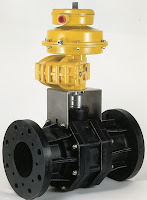 |
| Kinetrol Actuator on Thermoplastic Valves |
For example, many chemicals used to treat drinking water and wastewater use plastic valves because they stand up to the caustic and aggressive chemicals such as sodium hypochlorite, sodium hydroxide, sodium bisulfite, hydrofluosilisic acid and potassium permanganate.
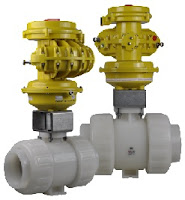 |
| Kinetrol Actuator on Thermoplastic Valves |
In the high purity industries such as the semiconductor industry, fluoropolymer valves are required for aqueous chemicals, solvents and slurries. In these applications chemical contamination must be less than 100 parts per trillion (ppt) total contamination from the entire piping system (including valves, fittings, tubing, filters and instrumentation). Other ultra-pure application examples are microelectronics, medical devices and pharmaceutical production.
Thermoplastic valves are sensitive to temperature changes and experience a higher degree of thermal expansion and contraction than their metal counterparts, but most agree the advantages far outweigh these concerns.
The key to actuating plastic valves is like any other valve system - understanding the operating requirements of system. It's important to remember that since most plastic valves are used on corrosive media, there's a fair chance the actuator may be exposed to corrosives as well. Effects on the actuator housing, internal parts, and any springs have to be considered. In most cases the actuator will have to be specially coated or come with a corrosion-resistant epoxy finish. Kinetrol actuators fit the bill as they come standardly with an epoxy stove enamel finish and stainless steel internal and external hardware, and Kinetrol spring units are totally sealed from the atmosphere, protecting the spring element and assuring long life.
Subscribe to:
Comments (Atom)





